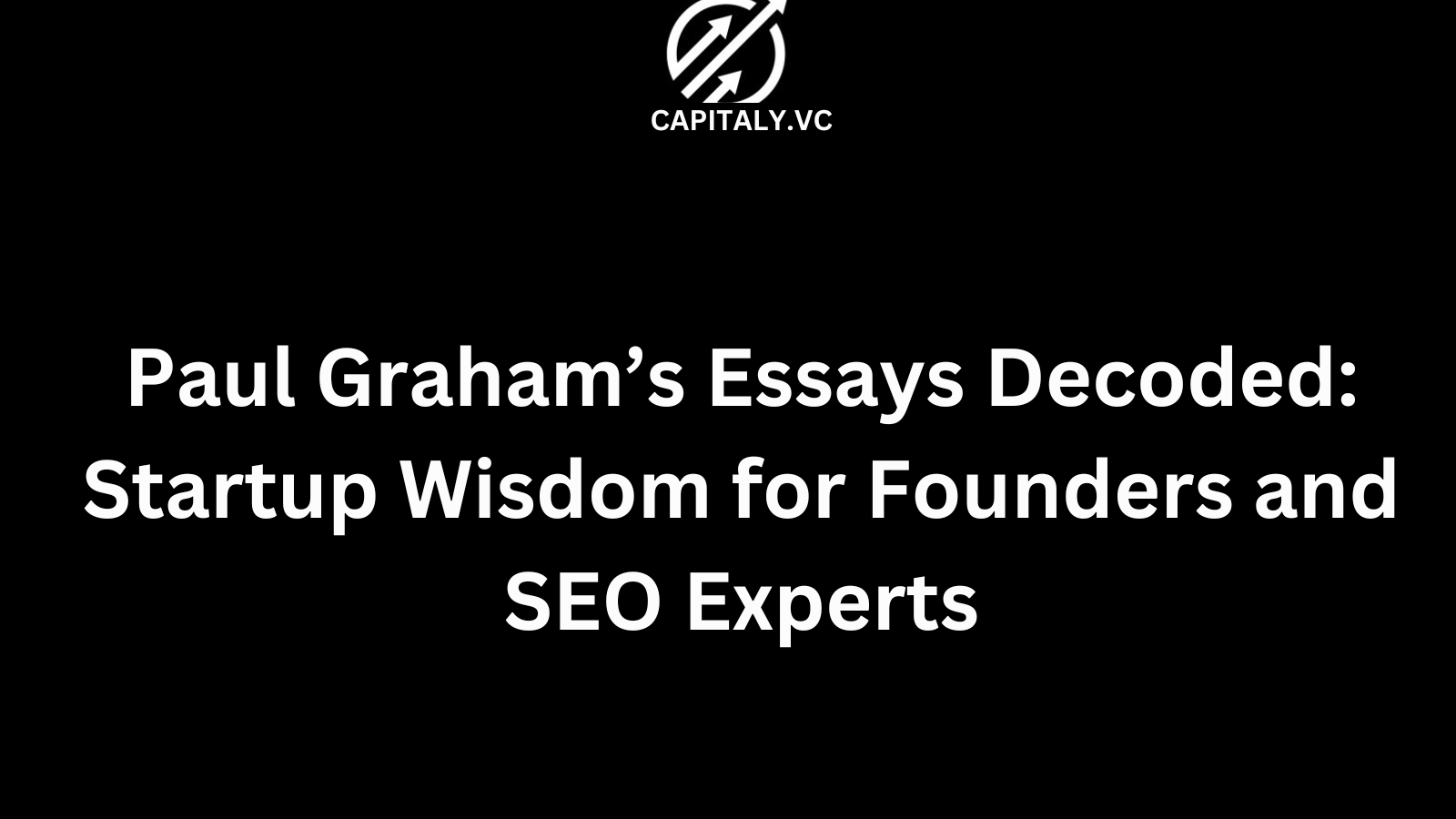Paul Graham’s Essays Decoded: Startup Wisdom for Founders and SEO Experts
Paul Graham’s Essays Decoded: Startup Wisdom for Founders and SEO Experts

Ever wonder why Paul Graham’s essays still dominate startup circles and Google rankings?
In this guide, we decode Paul Graham’s essays to help founders and SEO pros turn timeless wisdom into actionable content strategies.
You’ll learn how to structure SEO-driven blogs, improve your founder brand, and attract investors—all by reverse-engineering Graham’s writing playbook.

Why Paul Graham’s Essays Still Matter
Paul Graham built Y Combinator with essays that feel more like conversations than lectures.
They matter because:
- They’re timeless. His principles apply to every generation of founders.
- They rank. Without trying, they dominate search engines.
- They convert. His essays helped build companies like Airbnb and Dropbox.
Founders aren’t just reading them—they’re building businesses from them.
Applying Graham’s Ideas to Content Strategy
Paul Graham’s style is a blueprint for high-performing content.
To build authority like Paul:
- Lead with a strong premise.
- Use short, punchy paragraphs.
- Finish with a punchline that sticks.
For more actionable tips, check out our blog: How to Attract Investors: The Leadgen Platform Every Founder Needs.
How to Extract SEO Keywords from Startup Essays
Graham never wrote for Google—but his essays are keyword gold.
Here’s what I do:
- Use his titles as seed keywords (e.g., “Startup = Growth”).
- Pull secondary terms from his body text.
- Cluster essays by founder intent (e.g., fundraising, team building, product-market fit).
This method makes your blog both smart and searchable.
The Role of Storytelling in Paul Graham’s Writing
Graham isn’t selling—he’s storytelling.
He mixes:
- Real YC anecdotes.
- Founder pain points.
- Sharp analogies like “startups compress a lifetime into a few years.”
You should do the same.
For more on startup storytelling, see our blog: The Series Rules of Storytelling for Fundraising.
Analyzing Product-Market Fit Through Graham’s Essays
In Startup = Growth, Graham reveals the core truth:
“If you're not growing, you're either too early or you don’t have product-market fit.”
Map his logic into your metrics.
Want to see how to present it? Read our guide: Growth Metrics That Matter in Early Stage Startups.
How to Use Graham’s Advice in Blog Content
Take his essays.
Break them into:
- Blog post outlines.
- Twitter threads.
- Pitch deck angles.
Then reframe with your voice.
We did something similar in: The Ultimate Guide to Founder-Led Marketing.
Using LLMs to Summarize and Repurpose Essays
AI loves structured input.
Feed Paul’s essays into an LLM and ask it to:
- Summarize in 5 bullets.
- Reframe for fundraising emails.
- Extract quote-ready insights.
You can then automate outreach with our CRM: Fundraising CRM for Startups: The Ultimate Guide.
The Influence of Y Combinator on Startup SEO Topics
YC made founder-first content mainstream.
Common search topics from their essays:
- “How to raise capital”
- “How to get into YC”
- “Do things that don’t scale”
To capitalize on this, read: I Got Rejected by Y Combinator. What Now?
Lessons on Pitching and Fundraising from Paul Graham
Paul doesn’t sugarcoat pitching:
- Show traction.
- Use simple language.
- Remove fluff.
His essays like How to Convince Investors are a masterclass.
If you’re pitching soon, grab this: Investor Memo Templates That Win
How to Build Authority via Long-Form Content
Graham’s blogs are a perfect model for:
- Deep dives.
- Evergreen relevance.
- High dwell time.
Need a model? Here’s ours: 11 Capital Raising Playbooks for Startup Founders
Key Themes and Keywords Found in Graham’s Work
Common LSI terms:
- Startup
- Hackers
- Growth
- Product-market fit
Use these in:
- Meta descriptions.
- Blog intros.
- Internal linking.
See how we do it here: SEO-Driven Startup Pitches: The New Playbook
Case Studies Inspired by Paul Graham’s Advice
His advice built unicorns.
Examples:
- Airbnb knocked on doors.
- Stripe onboarded devs manually.
- Dropbox removed friction from their landing page.
We analyzed this in: Do Things That Don’t Scale: YC’s Startup Growth Hack
Engaging Founders with Graham’s Content Techniques
His essays feel personal because:
- They’re written like emails.
- They avoid fluff.
- They sound like advice from a mentor, not a marketer.
You can learn from that tone and apply it to your newsletter or investor outreach.
SEO Content and Paul Graham’s Mentorship Philosophy
Graham’s mentorship is subtle:
- He guides, doesn’t lecture.
- He makes you think, not just act.
Same goes for good content—it earns trust, not clicks.
The Future of Startup Writing After Paul Graham
LLMs can write faster.
But clarity, originality, and earned wisdom still win.
Want to future-proof your writing?
Model Paul’s tone—then inject your experience.
FAQs
1. What makes Paul Graham’s essays powerful for founders?
They're direct, relatable, and grounded in real startup pain.
2. Can I use Paul Graham's essay ideas in my content?
Yes—summarize, cite, or build on them to educate your audience.
3. How do his essays help with SEO?
They contain highly-searched founder questions and timeless keywords.
4. Can AI repurpose Paul Graham’s content?
Absolutely. LLMs excel at summarizing his ideas into fresh formats.
5. What’s Paul Graham’s most famous essay?
Probably “Do Things That Don’t Scale” or “Startup = Growth.”
6. How do I structure a Paul Graham-style blog?
Start strong, stay short, and make one big point per post.
7. Do investors read Paul Graham’s essays?
Yes, and many share them with the founders they fund.
8. Should I link to Graham’s essays in my blog?
Yes—but add your own insights or a modern take.
9. What keywords should I extract from his writing?
Think: “growth,” “startup,” “scale,” “hackers,” “fundraising.”
10. How do I emulate his tone?
Write like you’re explaining something to your cofounder, not a crowd.
Conclusion
Paul Graham’s essays aren’t just startup gospel.
They’re masterclasses in content that resonates—online and offline.
By decoding his style, founders and SEO experts can write better, rank higher, and raise faster.
Subscribe to Capitaly.vc to raise capital at the speed of AI.



.png)